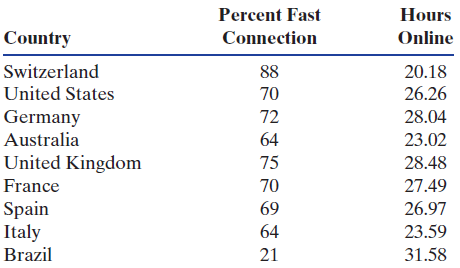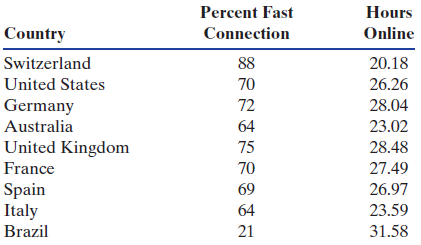In Exercise 2.109 on page 89, we discuss a study in which the Nielsen Company measured connection
Question:
Table 2.33

(a) What would a positive association mean between these two variables? Explain why a positive relationship might make sense in this context.
(b) What would a negative association mean between these two variables? Explain why a negative relationship might make sense in this context.
(c) Make a scatterplot of the data, using connection speed as the explanatory variable and time online as the response variable. Is there a positive or negative relationship? Are there any outliers? If so, indicate the country associated with each outlier and describe the characteristics that make it an outlier for the scatterplot.
(d) If we eliminate any outliers from the scatterplot, does it appear that the remaining countries have a positive or negative relationship between these two variables?
(e) Use technology to compute the correlation. Is the correlation affected by the outliers?
(f) Can we conclude that a faster connection speed causes people to spend more time online?
Exercise 2.109
The Nielsen Company measured connection speeds on home computers in nine different countries and wanted to determine whether connection speed affects the amount of time consumers spend online. Table 2.26 shows the percent of Internet users with a €˜€˜fast€ connection (defined as 2Mb or faster) and the average amount of time spent online, defined as total hours connected to the web from a home computer during the month of February 2011. The data are also available in the dataset GlobalInternet.
Table 2.26

Step by Step Answer:

Statistics Unlocking The Power Of Data
ISBN: 9780470601877
1st Edition
Authors: Robin H. Lock, Patti Frazer Lock, Kari Lock Morgan, Eric F. Lock, Dennis F. Lock





